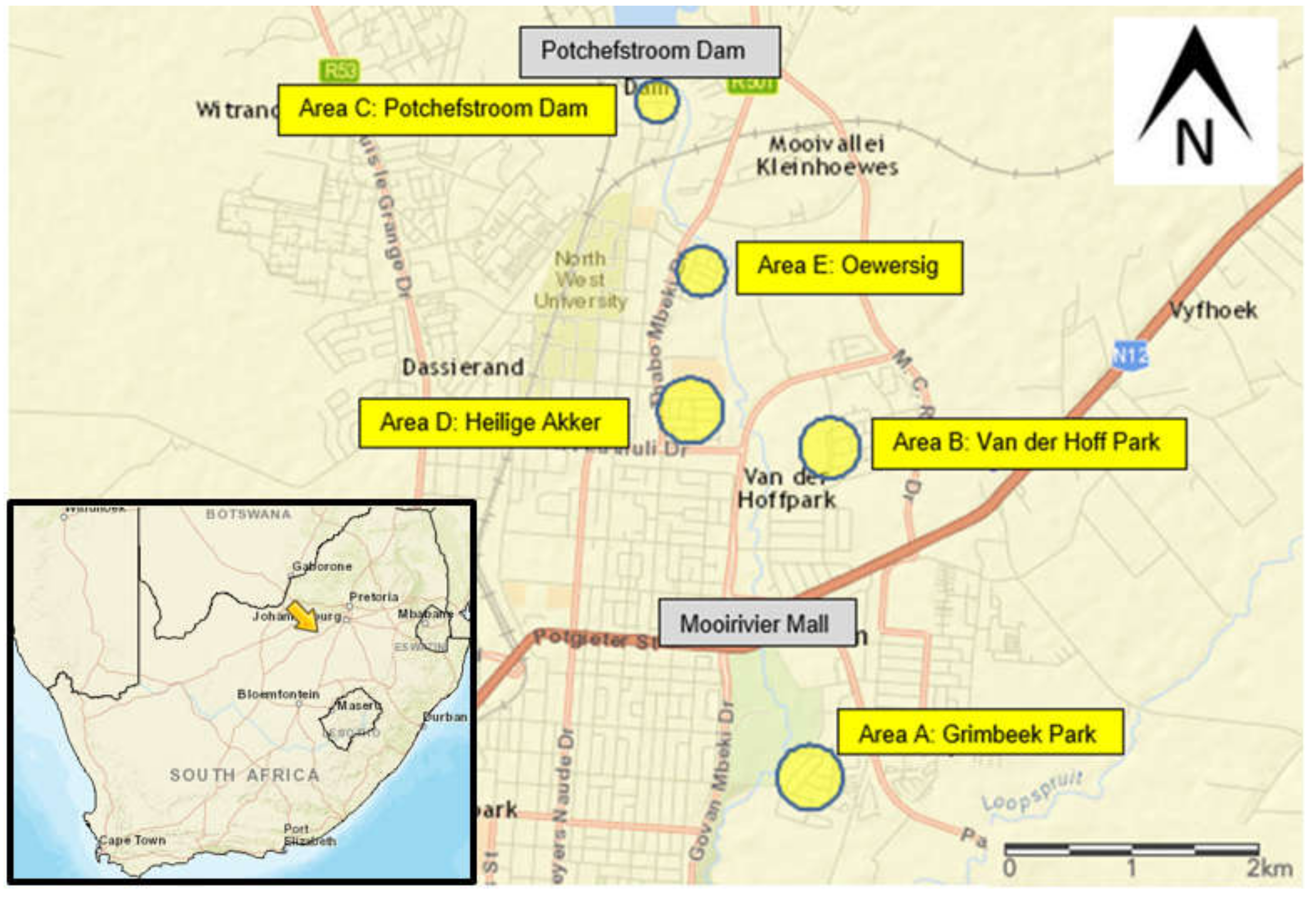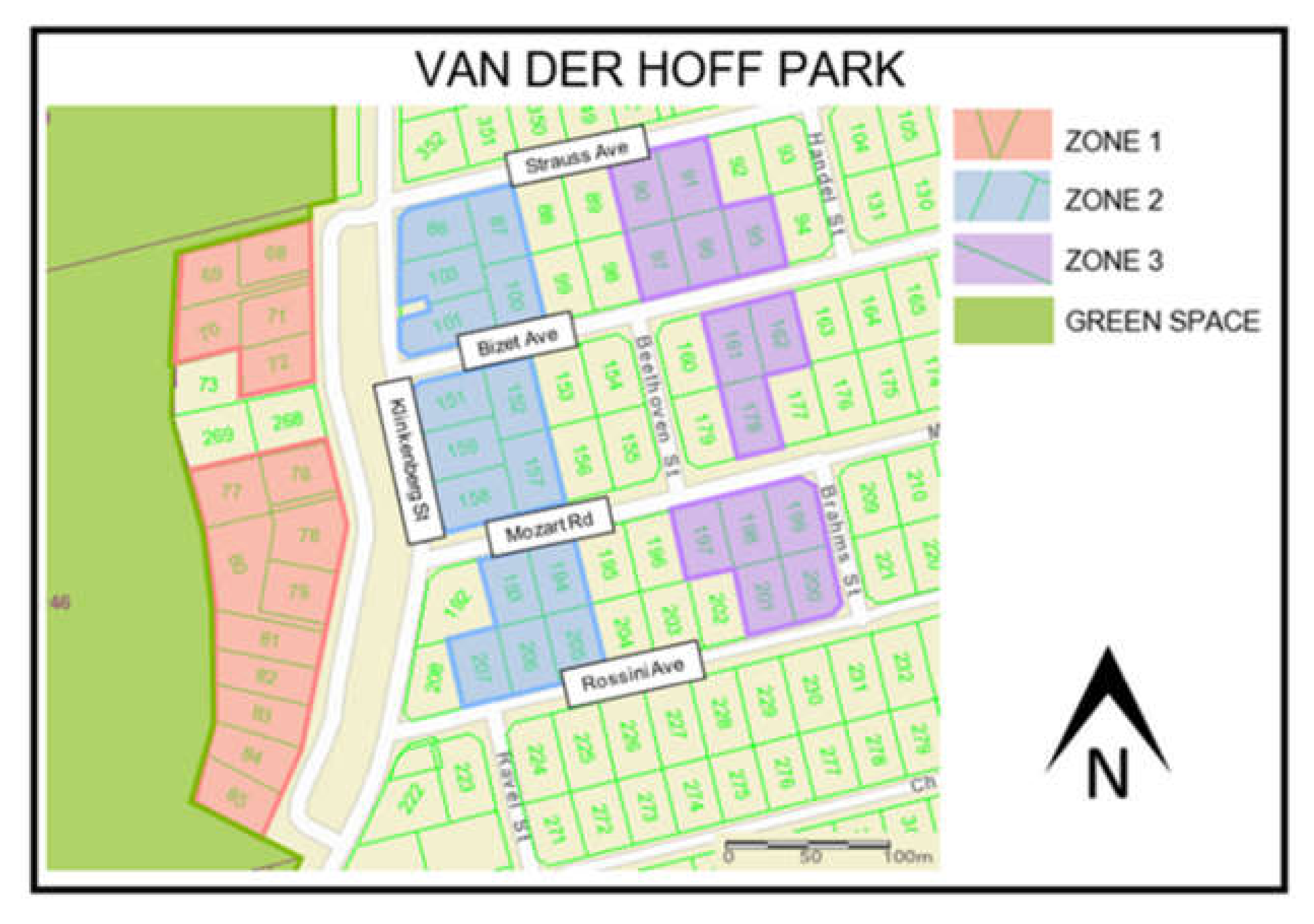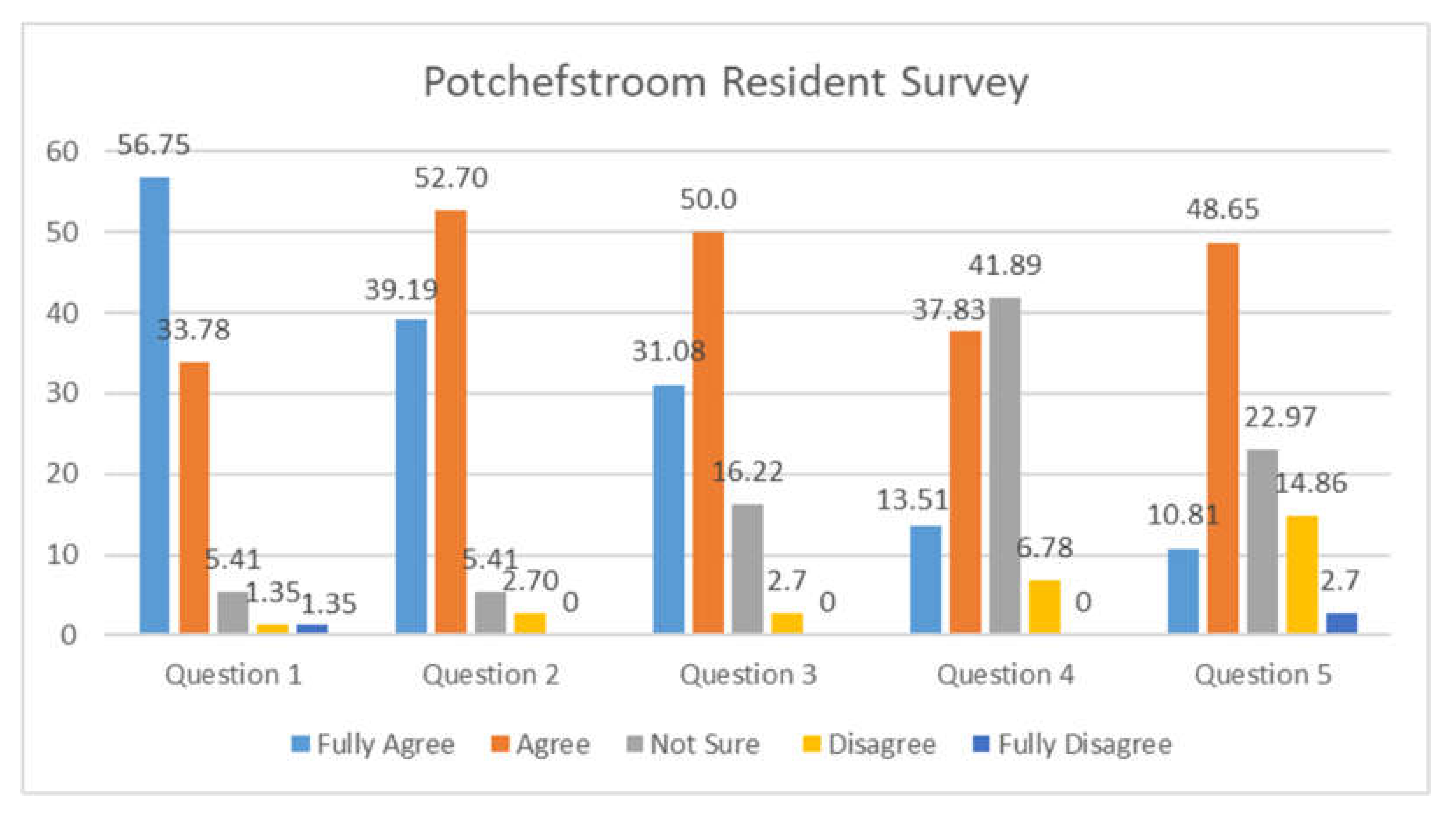Revisiting the Proximity Principle with Stakeholder Input: Investigating Property Values and Distance to Urban Green Space in Potchefstroom
Abstract
1. Introduction
1.1. Green Spaces in the South African Context
1.2. Ecosystem Services and Disservices
1.3. The Proximity Principle as A Hedonic Price Analysis Method
1.4. The Importance of Context and Planning at Community Level
2. Methodology
2.1. Data Acquisition Part A: Proximity Principle in Potchefstroom
- -
- Area A: Grimbeek Park, bordering the Potchefstroom Country Club
- -
- Area B: Van der Hoff Park, situated next to an equestrian open space and wetland.
- -
- Area C: Potchefstroom Dam Area, situated next to Potch Dam and the surrounding open space.
- -
- Area D: Heilige Akker, situated adjacent to the Fanie du Toit sports grounds.
- -
- Area E: Oewersig, situated adjacent to the Mooi River and surrounding open space.
2.2. Data Acquisition Part B: Community Survey and Professional Planner Survey
3. Data Analysis and Results
3.1. Data Results Part A: Proximity Principle in Potchefstroom
3.2. Data Results Part B: Community Survey and Professional Planner Survey
3.2.1. Potchefstroom Resident Survey
3.2.2. Professional Planner Survey
4. Conclusions
5. Recommendations
5.1. Future In-Depth Research Based on This Paper’s Preliminary Findings
5.2. Municipal Valuations Should be Reviewed
5.3. Enhance Both the Quality and Quantity of Green Spaces
5.4. Prioritise Environmental Considerations in Mainstream Urban Planning
5.5. A Broader Spatial Planning Approach
5.6. Focus on Context-Based Planning
Author Contributions
Funding
Acknowledgments
Conflicts of Interest
References
- Cilliers, E.J.; Timmermans, W. An Integrative Approach to Value-Added Planning: From Community Needs to Local Authority Revenue. Growth Chang. 2015, 46, 675–687. [Google Scholar] [CrossRef]
- Bolund, P.; Hunhammar, S. Ecosystem services in urban areas. Ecol. Econ. 1999, 29, 293–301. [Google Scholar] [CrossRef]
- Gómez-Baggethun, E.; Gren, A.; Barton, D.N.; Langemeyer, J.; McPhearson, T.; O’Farrell, P.; Andersson, E.; Hamstead, Z.; Kremer, P. Urbanization, Biodiversity and Ecosystem Services: Challenges and Opportunities; Springer: London, UK, 2013; pp. 175–251. [Google Scholar]
- O’Brien, E. Social housing and green space: A case study in Inner London. Forestry 2006, 79, 535. [Google Scholar] [CrossRef]
- Cilliers, J.; Timmermans, W. Approaching value added planning in the green environment. J. Place Manag. Dev. 2013, 6, 144–154. [Google Scholar] [CrossRef]
- Cilliers, E.J. Rethinking Sustainable Development: The Economic Value of Green Spaces. PhD. Thesis, North-West University, Potchefstroom, South Africa, 2010. [Google Scholar]
- Vandermeulen, V.; Verspecht, A.; Vermeire, B.; Van Huylenbroeck, G.; Gellynck, X. The use of economic valuation to create public support for green infrastructure investments in urban areas. Landsc. Urban Plan. 2011, 103, 198–206. [Google Scholar] [CrossRef]
- Melichar, J.; Vojáček, O.; Rieger, P.; Jedlička, K. Measuring the value of urban forest using the Hedonic price approach. Reg. Stud. 2009, 2, 13–20. [Google Scholar]
- Klimas, C.; Williams, A.; Hoff, M.; Lawrence, B.; Thompson, J.; Montgomery, J. Valuing ecosystem services and disservices across heterogeneous green spaces. Sustainability 2016, 8, 853. [Google Scholar] [CrossRef]
- Nicholls, S.; Crompton, J.L. The impact of greenways on property values: Evidence from Austin, Texas. J. Leis. Res. 2005, 37, 321–341. [Google Scholar] [CrossRef]
- Czembrowski, P.; Laszkiewicz, E.; Kronenberg, J.; Engström, G.; Andersson, E. Valuing individual characteristics and the multifunctionality of urban green spaces: The integration of sociotope mapping and hedonic pricing. PLoS ONE 2019, 14, 1–16. [Google Scholar] [CrossRef]
- Cilliers, S.; Cilliers, J. From green to gold: A South African example of valuing urban green spaces in some residential areas in Potchefstroom. Town Reg. Plan. 2015, 67, 1–12. [Google Scholar]
- Girma, Y.; Terefe, H.; Pauleit, S.; Kindu, M. Urban green spaces supply in rapidly urbanizing countries: The case of Sebeta Town, Ethiopia. Remote Sens. Appl. Soc. Environ. 2019, 13, 138–149. [Google Scholar] [CrossRef]
- Wolch, J.R.; Byrne, J.; Newell, J.P. Urban green space, public health, and environmental justice: The challenge of making cities ‘just green enough’. Landsc. Urban Plan. 2014, 125, 234–244. [Google Scholar] [CrossRef]
- du Toit, M.J.; Cilliers, S.S.; Dallimer, M.; Goddard, M.; Guenat, S.; Cornelius, S.F. Urban green infrastructure and ecosystem services in sub-Saharan Africa. Landsc. Urban Plan. 2018, 180, 249–261. [Google Scholar] [CrossRef]
- Schäffler, A.; Swilling, M. Valuing green infrastructure in an urban environment under pressure—The Johannesburg case. Ecol. Econ. 2013, 86, 246–257. [Google Scholar] [CrossRef]
- Cilliers, J. Economic value of green spaces: South Africa in contrast with Europe. Acta Acad. 2013, 45, 1–27. [Google Scholar]
- Lategan, L.G.; Cilliers, E.J. The value of public green spaces and the effects of South Africa’s informal backyard rental sector. WIT Trans. Ecol. Environ. 2014, 191, 427–438. [Google Scholar]
- Lubbe, C.S.; Siebert, S.J.; Cilliers, S.S. Political legacy of South Africa affects the plant diversity patterns of urban domestic gardens along a socioeconomic gradient. Sci. Res. Essays 2010, 5, 2900–2910. [Google Scholar]
- Kabisch, N.; Korn, H.; Stadler, J.; Bonn, A. Nature-based Solutions to Climate Change Adaptation in Urban Areas: Theory and Practice of Urban Sustainability Transitions; Springer: Cham, Switzerland, 2017; p. 215. [Google Scholar]
- Cilliers, E.J. Urban green compensation. Int. J. Green Econ. 2012, 6, 346–356. [Google Scholar] [CrossRef]
- Biao, Z.; Gaodi, X.; Bin, X.; Canqiang, Z. The effects of public green spaces on residential property value in Beijing. J. Resour. Ecol. 2012, 3, 243–253. [Google Scholar] [CrossRef]
- Funmilayo, O.A.; Adegboyega, S.A.; Orimoogunje, O.O.; Banjo, O.O. Population growth: Implications for environmental sustainability. IFE Psychol. Int. J. 2011, 19, 56–69. [Google Scholar]
- Simpeh, K.; Smallwood, J. Analysis of the benefits of green building in South Africa. J. Constr. Proj. Manag. Innov. 2018, 8, 1829–1851. [Google Scholar]
- Elmqvist, T.; Setälä, H.; Handel, S.N.; Van der Ploeg, S.; Aronson, J.; Blignaut, J.N.; Gömez-Baggethun, E.; Nowak, D.J.; Kronenberg, J.; De Groot, R. Benefits of restoring ecosystem services in urban areas. Curr. Opin. Environ. Sustain. 2015, 14, 101–108. [Google Scholar] [CrossRef]
- Silvennoinen, S.; Setälä, H.; Taka, M.; Koivusalo, H.; Yli-Elkonen, V.; Ollikainen, M. Monetary value of urban green space as an ecosystem service provider: A case study of urban runoff management in Finland. Ecosyst. Serv. 2017, 28, 17–27. [Google Scholar] [CrossRef]
- Tyrväinen, L.; Väänänen, H. The economic value of urban forest amenities: An application of the contingent valuation method. Landsc. Urban Plan. 1998, 43, 105–118. [Google Scholar] [CrossRef]
- Ives, C.D.; Oke, C.; Hehir, A.; Gordon, A.; Wang, Y.; Bekessy, S.A. Capturing residents’ values for urban green space: Mapping, analysis and guidance for practice. Landsc. Urban Plan. 2017, 161, 32–43. [Google Scholar] [CrossRef]
- de Wit, M.; van Zyl, H.; Crookes, D.; Blignaut, J.; Jayiya, T.; Goiset, V.; Mahumani, B. Including the economic value of well-functioning urban ecosystems in financial decisions: Evidence from a process in Cape Town. Ecosyst. Serv. 2012, 2, 38–44. [Google Scholar] [CrossRef]
- Lategan, L.; Cilliers, J. Considering urban green space and informal backyard rentals in South Africa: Disproving the compensation hypothesis. Town Reg. Plan. 2016, 69, 1–6. [Google Scholar] [CrossRef]
- Cilliers, S.; Cilliers, J.; Lubbe, R.; Siebert, S. Ecosystem services of urban green spaces in African countries—perspectives and challenges. Urban Ecosyst. 2013, 16, 681–702. [Google Scholar] [CrossRef]
- Van Leeuwen, E.; Nijkamp, P.; de Noronha Vaz, T. The multifunctional use of urban greenspace. Int. J. Agric. Sustain. 2010, 8, 20–25. [Google Scholar] [CrossRef]
- Panduro, T.E.; Veie, K.L. Classification and valuation of urban green spaces—A hedonic house price valuation. Landsc. Urban Plan. 2013, 120, 119–128. [Google Scholar] [CrossRef]
- Daams, M.N.; Sijtsma, F.J.; van der Vlist, A.J. The effect of natural space on nearby property prices: Accounting for perceived attractiveness. Land Econ. 2016, 92, 389–410. [Google Scholar] [CrossRef]
- Cilliers, E.J.; Timmermans, W.; Van den Goorbergh, F.; Slijkhuis, J. Green Place-making in Practice: From Temporary Spaces to Permanent Places. J. Urban Des. 2015, 20, 349–366. [Google Scholar] [CrossRef]
- Haaland, C.; Van den Bosch, C.K. Review: Challenges and strategies for urban green-space planning in cities undergoing densification: A review. Urban For. Urban Green. 2015, 14, 760–771. [Google Scholar] [CrossRef]
- Adegun, O.B. Residents’ relationship with green infrastructure in Cosmo City, Johannesburg. J. Urban 2018, 11, 329–346. [Google Scholar] [CrossRef]
- Dempsey, N.; Burton, M. Defining place-keeping: The long-term management of public spaces. UrbanForestry Urban Green. 2012, 11, 11–20. [Google Scholar] [CrossRef]
- Ellis, S.M.; Steyn, H.S. Practical significance (effect sizes) versus or in combination with statistical significance (p-values). Manag. Dyn. 2003, 12, 51–53. [Google Scholar]
- Inflation.eu. Available online: https://www.inflation.eu/inflation-rates/south-africa/historic-inflation/cpi-inflation-south-africa-2013.aspx (accessed on 29 August 2019).
- Luüs, C. The Absa Residential Property Market Database for South Africa - Key Data Trends and Implications. Available online: https://www.bis.org/publ/bppdf/bispap21l.pdf (accessed on 5 June 2020).
- Hill Country News. Available online: http://hillcountrynews.com/stories/new-mixed-use-development-planned-in-cedar-park,78057 (accessed on 10 October 2019).
- South Africa. Spatial Planning and Land Use Management Act; Act 16 of 2013, Gazette 36730 South Africa; South African Government: Cape Town, South Africa, 2013.
- Tekel, A.; Akbarishahabi, L. Determination of Open-green Space’s Effect on Around House Prices by Means of Hedonic Price Model; in Example of Ankara/Botanik Park. Gazi Univ. J. Sci. 2013, 26, 347–361. [Google Scholar]




| UGS Benefit Categories | Type of Ecosystem Service or Benefits | Examples of Benefits and Services |
|---|---|---|
| Environmental (indirect benefits) | Regulating services | Improved air and water quality, reduction of urban heat island effect, regulating urban temperature, moderating extreme events such as flooding, waste water treatment, erosion control, pollination, biological control |
| Supporting services | Enhancing urban biodiversity (presence of suitable urban habitats), conservation of natural ecosystems | |
| Provisioning services | Protection and restoration of natural resources to provide water, food and medicine | |
| Social (indirect benefits) | Cultural services | Improves mental and physical health, aesthetic value of dense urban centres, encourages social cohesion, promotes sense of place, strengthens historical and cultural values |
| Economic (direct benefits) | Economic benefits | Replacement of expensive conventional and technical environmental management systems (e.g., storm water management), water retention, microclimate regulation through green spaces and areas of permeable surfaces, pollution reduction, physical and physiological health benefits, increase in property value (“willingness to pay” of property buyers), increase in property tax returns of municipalities, increases the marketability of a city |
| Category | General Example | South African Example |
|---|---|---|
| Ecological | Invasive species that outcompete indigenous species, change in species interactions and populations, change in abiotic species variables, decrease in air quality due to production on volatile organic compounds (VOC’s) | Similar to general examples |
| Social (negative impact on human wellbeing) | Security concerns, negative health impact (allergic reaction to VOC’s and pollen), high levels of noise, unpleasant due to exposure to the elements (excessive winds), safety hazard (tree falls), poisonous plants and pests | Unsafe (frequent criminal activity and drug trade), aesthetically unpleasing due to a lack of maintenance and littering, unappealing and nuisance, initial plan for land use not followed through (play area for children) |
| Economic and financial | Damage to infrastructure (tree roots), maintenance costs, promoting accessibility to green space | Sensitive approaches to green space planning in low-income areas to address ecosystem disservices, fragmented town and cities due to apartheid era resulted in lower-income groups being located far away from green spaces with high transportation cost to access green spaces and child friendly areas. |
| Area | Zone | N (188) | R/m2 | ANOVA Effect Sizes | Kruskal-Wallis Effect Sizes | ANOVA p-Values | Kruskal-Wallis p-Values | ||
|---|---|---|---|---|---|---|---|---|---|
| a ≈ 0.2 small (No practically sig. diff.) b ≈ 0.5 medium (Practically visible diff.) c ≈ 0.8 large (Practically sig. diff.) | a ≈ 0.1 small (No practically sig. diff.) b ≈ 0.3 medium (Practically visible diff.) c ≈ 0.5 large (Practically sig. diff.) | Statistically significant difference between the means (p ˂ 0.05) | Statistically significant difference between the groups (p ˂ 0.05) | ||||||
| 1 with… | 2 with… | 1 with… | 2 with… | ||||||
| Grimbeek Park | 1 | 14 | 1260.70 | 0.0002 | 0.0006 | ||||
| 2 | 14 | 1611.67 | 1.19 c | 0.54 c | |||||
| 3 | 13 | 1699.25 | 1.63 c | 0.30 a | 0.68 c | 0.23 b | |||
| Van der Hoff Park | 1 | 15 | 1290.59 | 0.015 | 0.005 | ||||
| 2 | 15 | 1472.43 | 0.53 b | 0.38 b | |||||
| 3 | 13 | 1624.30 | 0.98 c | 0.54 b | 0.58 c | 0.27 b | |||
| Potchefstroom Dam Area | 1 | 9 | 1116.44 | 0.396 | 0.237 | ||||
| 2 | 9 | 1303.45 | 0.53 b | 0.43 c | |||||
| 3 | 9 | 1448.64 | 0.44 b | 0.19 a | 0.26 b | 0.09 a | |||
| Heilige Akker | 1 | 10 | 1751.96 | 0.641 | 0.640 | ||||
| 2 | 12 | 1904.15 | 0.42 b | 0.17 a | |||||
| 3 | 14 | 1850.28 | 0.24 a | 0.13 a | 0.07 a | 0.15 a | |||
| Oewersig | 1 | 14 | 1668.44 | 0.105 | 0.052 | ||||
| 2 | 14 | 1852.15 | 0.44 b | 0.26 b | |||||
| 3 | 13 | 1549.20 | 0.36 b | 0.72 c | 0.23 b | 0.45 c | |||
| Area | Zone | N (188) | R/m2 Old | R/m2 New | % Increase between Old and New | Effect Sizes | Dependent T-Test |
|---|---|---|---|---|---|---|---|
| a ≈ 0.2 small b ≈ 0.5 medium c ≈ 0.8 large | Statistically significant difference between Old and New (p ˂ 0.05) | ||||||
| Area A: Grimbeek Park | 1 | 14 | 798.20 | 1260.70 | 68% | 1.13 | 0.006 |
| 2 | 14 | 953.12 | 1611.67 | 1.64 | 0.001 | ||
| 3 | 13 | 974.76 | 1699.25 | 0.69 | 0.011 | ||
| Area B: Van der Hoff Park | 1 | 15 | 938.29 | 1290.59 | 35% | 1.95 | 0.0001 |
| 2 | 15 | 1105.07 | 1472.43 | 2.23 | 0.0001 | ||
| 3 | 13 | 1202.56 | 1624.30 | 2.69 | 0.0001 | ||
| Area C: Potchefstroom Dam Area | 1 | 9 | 718.97 | 1116.44 | 55% | 1.88 | 0.0001 |
| 2 | 9 | 843.41 | 1303.45 | 1.36 | 0.0001 | ||
| 3 | 9 | 925.29 | 1448.64 | 1.47 | 0.0001 | ||
| Area D: Heilige Akker | 1 | 10 | 1114.23 | 1751.96 | 46% | 1.75 | 0.0001 |
| 2 | 12 | 1413.52 | 1904.15 | 1.33 | 0.0001 | ||
| 3 | 14 | 1238.36 | 1850.28 | 1.39 | 0.0001 | ||
| Area E: Oewersig | 1 | 14 | 1079.50 | 1668.44 | 45% | 1.03 | 0.0001 |
| 2 | 14 | 1292.09 | 1852.15 | 1.54 | 0.0001 | ||
| 3 | 13 | 1120.30 | 1549.20 | 1.51 | 0.0001 |
© 2020 by the authors. Licensee MDPI, Basel, Switzerland. This article is an open access article distributed under the terms and conditions of the Creative Commons Attribution (CC BY) license (http://creativecommons.org/licenses/by/4.0/).
Share and Cite
Combrinck, Z.; Cilliers, E.J.; Lategan, L.; Cilliers, S. Revisiting the Proximity Principle with Stakeholder Input: Investigating Property Values and Distance to Urban Green Space in Potchefstroom. Land 2020, 9, 235. https://doi.org/10.3390/land9070235
Combrinck Z, Cilliers EJ, Lategan L, Cilliers S. Revisiting the Proximity Principle with Stakeholder Input: Investigating Property Values and Distance to Urban Green Space in Potchefstroom. Land. 2020; 9(7):235. https://doi.org/10.3390/land9070235
Chicago/Turabian StyleCombrinck, Zene, Elizelle Juanee Cilliers, Louis Lategan, and Sarel Cilliers. 2020. "Revisiting the Proximity Principle with Stakeholder Input: Investigating Property Values and Distance to Urban Green Space in Potchefstroom" Land 9, no. 7: 235. https://doi.org/10.3390/land9070235
APA StyleCombrinck, Z., Cilliers, E. J., Lategan, L., & Cilliers, S. (2020). Revisiting the Proximity Principle with Stakeholder Input: Investigating Property Values and Distance to Urban Green Space in Potchefstroom. Land, 9(7), 235. https://doi.org/10.3390/land9070235







